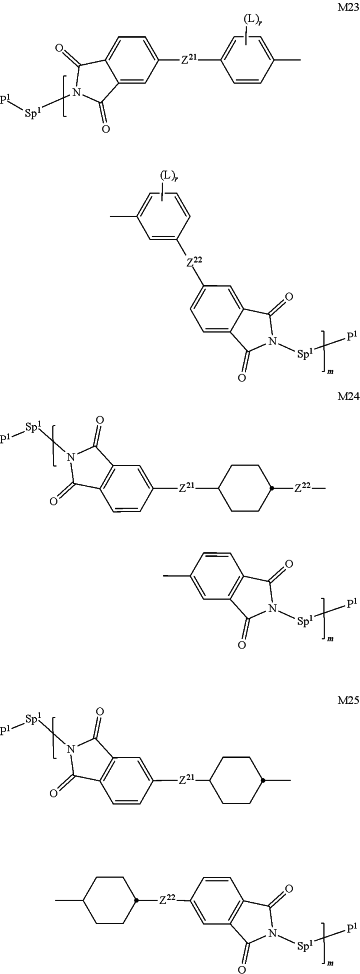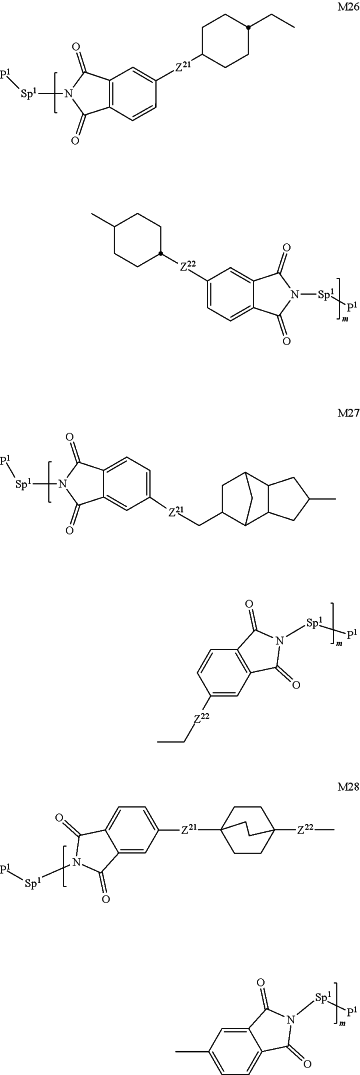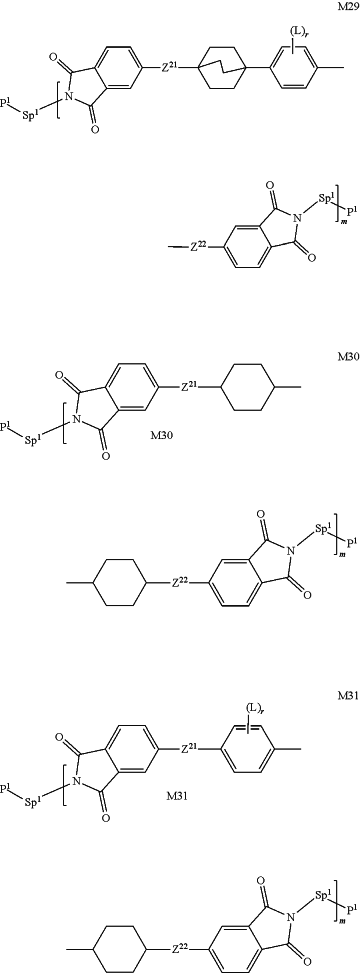| CPC C09K 19/3895 (2013.01) [C09K 19/408 (2013.01); C09K 2019/0448 (2013.01)] | 16 Claims |

|
1. A polymerizable mixture comprising:
a first monomer and a second monomer,
wherein the first monomer is one or more selected from formulae M1 to M31:
         wherein:
m is an integer from 1 to 60;
P1 denotes
 Sp1 denotes at each occurrence a spacer group Sp;
Z21 and Z22 are independently and at each occurrence independently from each other, —O—, —S—, —CO—, —COO—, —OCO—, —S—CO—, —CO—S—, —O—COO—, —CO—NR01—, —NR01CO—, —NR01—CO—NR02, —NR01—CO—O, —O—CO—NR01, —O—CO—NR01, —OCH2—, —CH2O—, —SCH2—, —CH2S—, —CH2CH2—, —(CH2)4—, —CH═N—, —N═CH—, —N═N—, —CH═CR01—, —CY01═CY02—, —C≡C—, —CH═CH—COO—, —OCO—CH═CH—, or a single bond;
R01 and R02 each, independently of one another, denote H or alkyl having 1 to 12 C atoms;
L is Cl, Br, I, —CN, —NO2, —NCO, —NCS, —OCN, —SCN, —C(═O)NRxxRyy, —C(═O)ORxx, —C(═O)Rxx, —NRxxRyy, —OH, −SF5, straight chain alkyl or alkoxy having 1 to 20 C atoms, branched chain alkyl or alkoxy having 3 to 20 C atoms, straight chain alkylcarbonyl, alkoxycarbonyl, alkylcarbonyloxy, or alkoxycarbonyloxy with 2 to 20 C atoms, or branched chain alkylcarbonyl, alkoxycarbonyl, alkylcarbonyloxy, or alkoxycarbonyloxy having 4 to 20 C atoms wherein, in said alkyl, alkoxy, alkylcarbonyl, alkoxycarbonyl, alkylcarbonyloxy, or alkoxycarbonyloxy groups, one or more H atoms are each optionally replaced by F, Cl, —CN, straight chain alkyl or alkoxy having 1 to 6 C atoms, branched chain alkyl or alkoxy having 3 to 6 C atoms, straight chain alkylcarbonyl, alkoxycarbonyl, alkylcarbonyloxy, or alkoxycarbonyloxy with 2 to 6 C atoms, or branched chain alkylcarbonyl, alkoxycarbonyl, alkylcarbonyloxy, or alkoxycarbonyloxy with 4 to 6 C atoms;
Rxx and Ryy independently of each other denote H or alkyl with 1 to 12 C-atoms;
Y01 and Y02 each, independently of one another, denote H, alkyl having 1 to 12 C atoms, aryl, Cl, or CN;
r is 0, 1, 2, 3 or 4;
s is 0, 1, 2 or 3; and
t is 0, 1 or 2;
wherein the second monomer is one or more bi- or multifunctional compounds capable of reacting with the first monomer to give a copolymer, wherein the second monomer is one or more bi- or multifunctional compounds comprising two or more polymerizable groups, P, which are selected from groups containing a C═C double bond, groups containing two conjugated C═C double bonds, nucleophilic groups, and 1,3-dipolar groups.
|